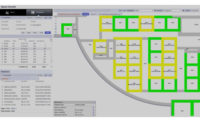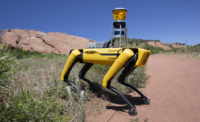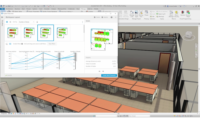The frustrations of working on complex design files across multiple software platforms are real, and have only been compounded as BIM files grow in size and complexity. Architects and engineers, working in Revit, Tekla, Grasshopper and other design tools often end up spending extra time to ensure data imported and exported between these platforms transfers smoothly.
In an effort to create a common environment for design visualizations, Autodesk has partnered with Nvidia to bring its broad suite of design software to Nvidia's Omniverse, a recently launched collaborative 3D environment that allows users of different software to see their 3D designs in one shared online space. Using Nvidia’s RTX technology and built upon Pixar’s Universal Scene Description (USD) format and Nvidia’s open-source Material Definition Library (MDL), Omniverse can fully display the live building models in real-time, drawing data from a range of applications in real-time. This allows collaboration between users across the world and among different design software applications.
“A lot of our customers don’t use Autodesk software exclusively,” says Amy Bunszel, senior vice president of design and construction products at Autodesk. While many Autodesk products already have the ability to send data back and forth, they lacked a single, online visualizer. Omniverse will allow for even competing design software to be used in the same shared space as Autodesk’s suite, without any additional work to import or export design files.
While Omniverse was not purpose-built for design and engineering, Nvidia decided it would be useful to industries other than entertainment and media, particularly during the remote work situations of the COVID-19 pandemic. “It works in different markets. We now have this common platform to bring out to all our [industries],” says Richard Kerris, Nvidia general manager for media and entertainment.
Omniverse runs on Nvidia’s RTX technology, which allows for a level of real-time 3D visualization with ray-tracing for realistic simulations of building lighting conditions. “With this we can simulate reality with physics and real-world lighting and rendering, and it allows collaborators to work across the room or the globe, as it all runs in the cloud,” explains Kerris.
Promising Results
The Omniverse platform recently entered into open beta for other industries, but so far only a few select architects and engineers have had access to its AEC software features. Kohn Pedersen Fox Associates has been running its own internal tests of Omniverse and so far the results have been promising, according to Cobus Bothma, director of applied research at KPF. “We can have two to three offices working on one project, and now they can collate these large data sets and visualize them much more accurately.”
Bothma has had teams working on the same model in Omniverse with users in different applications, allowing for different disciplines to better test out ideas in real time. “We have two very large Revit files running live, with Rhino and Grasshopper [instances] as well. It’s important for us to have multiple applications.” Working in Omniverse, the different teams can make live adjustments to the model in the software they know, while “the left-hand side is a working view, not a render, in real-time,” explains Bothma. KPF has also tested the remote collaboration features of Omniverse, with offices around the world logging in to work on the same model. “We have tested connections from New York to London. We’ve had Revit and Rhino running off machines in my house and in offices. Everything is dislocated, nothing is on a LAN or closed network.”
While KPF has only taken the first steps to using Omniverse on real projects, Bothma says he expects the time savings from not having to build connections between different software packages will be huge. “With one airport project—put on hold for COVID—we had to spend two to three weeks optimizing and writing scripts to get it into a virtual environment for the client to navigate.” But with Omniverse doing the heavy lifting, that work could be eliminated. “Pushing 15 million polygons is not difficult for Nvidia, so that cuts two to three weeks off of our optimization,” he says.
While Bothma is primarily using Omniverse with powerful PC workstations to run the design software, there is also potential to let users on less-powerful devices log into the session and contribute as well. “We could stream this big Revit model, 12 to 14 million polygons, to devices like iPhones or iPads,” he says. “Real-time renderers have changed the way we work in the last few years, but it’s still very centralized. This definitely will change the way we work, with so many more people able to work on it and make decisions.”
Nvidia Omniverse for AEC is currently open for pre-registration for users, with the full platform expected to be available later in the fall.






Post a comment to this article
Report Abusive Comment